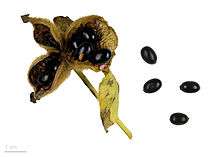Paeonia officinalis
Paeonia officinalis, the common peony,[1] or garden peony,[2] is a species of flowering plant in the family Paeoniaceae, native to France, Switzerland and Italy. It is a herbaceous perennial growing to 60–70 cm (24–28 in) tall and wide, with leaves divided into 9 leaflets, and bowl-shaped deep pink or deep red flowers, 10–13 cm (4–5 in) in diameter, in late spring (May in the Northern Hemisphere).[3]
| Paeonia officinalis | |
|---|---|
| Scientific classification | |
| Kingdom: | Plantae |
| Clade: | Tracheophytes |
| Clade: | Angiosperms |
| Clade: | Eudicots |
| Order: | Saxifragales |
| Family: | Paeoniaceae |
| Genus: | Paeonia |
| Species: | P. officinalis |
| Binomial name | |
| Paeonia officinalis | |

Paeonia officinalis was first used for medicinal purposes, then grown as an ornamental. Many selections are now used in horticulture, though the typical species is uncommon. Paeonia officinalis is still found wild in Europe.[4]
The cultivar 'Rubra Plena' (deep crimson double flowered) has gained the Royal Horticultural Society's Award of Garden Merit.[5]
Taxonomy
Many synonyms exist for Paeonia officinalis, i.e. Moutan officinalis, Paeonia anemoniflora, P. barrii, P. baxteri, P. commutata, P. elegans, P. feminea, P. festiva, P. fimbrata, P. foemina, P. fulgens, P. fulgida, P. hirsuta, P. lanceolata, P. lobata, P. mollis, P. nemoralis, P. paradoxa var. fimbrata, P. peregrina var. officinalis, f. officinalis, P. porrigens, P. promiscua, P. pubens, P. rubens, P. sessiliflora, P. splendens, P. subternata, P. versicolor.
Genetics
The common peony is an allotetraploid with two double sets of chromosomes from different parents (2n+2m=20), so it is a hybrid or nothospecies. One of the parents is most likely Paeonia peregrina. The other parent is one of the group of very closely related species, Paeonia parnassica, P. arietina and P. humilis. Both these parents are tetraploids themselves. P. officinalis has by far the most extensive range and is one of the more abundant species in the Mediterranean region.[6]
Distribution
The common peony is known from the south of France, through Switzerland to the middle of Italy.[7]
References
- "Paeonia officinalis". Natural Resources Conservation Service PLANTS Database. USDA. Retrieved 30 January 2016.
- "BSBI List 2007". Botanical Society of Britain and Ireland. Archived from the original (xls) on 2015-01-25. Retrieved 2014-10-17.
- RHS A-Z encyclopedia of garden plants. United Kingdom: Dorling Kindersley. 2008. p. 1136. ISBN 978-1405332965.
- Halda, Josef J.; Waddick, James W. (2004). The Genus Paeonia. Timber Press. p. 196. ISBN 978-0-88192-612-5.
- "RHS Plant Selector - Paeonia officinalis 'Rubra Plena'". Archived from the original on 13 September 2019. Retrieved 25 May 2013.
- Ferguson, Diane; Sang, Tao (2001). "Speciation through homoploid hybridization between allotetraploids in peonies (Paeonia)" (PDF). Proceedings of the National Academy of Sciences of the United States of America. 98 (7): 3915–3919. doi:10.1073/pnas.061288698. PMC 31153. PMID 11259655. Retrieved 2016-04-30.
- Sang, Tao; Crawford, Daniel J.; Stuessy, Tod F. (1995). "Documentation of reticulate evolution in peonies (Paeonia) using internal transcripted spacer sequences of nuclear ribosomal DNA: Implications for biogeography and concerted evolution". Proceedings of the National Academy of Sciences of the United States of America. 92 (15): 6813–6817. doi:10.1073/pnas.92.15.6813. PMC 41419. PMID 7624325.
External links

